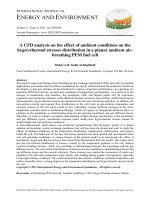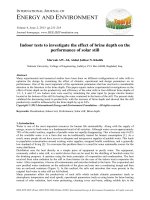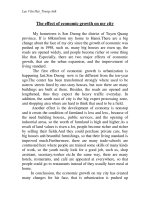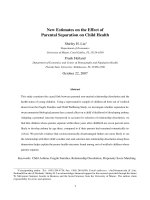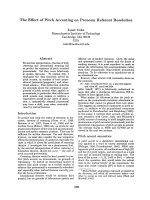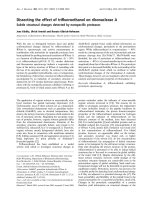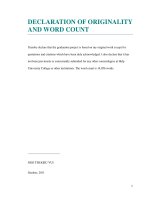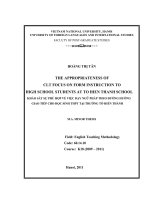THE EFFECT OF CLASSROOM INTERACTION ON DEVELOPING NON-ENGLISH MAJOR SOPHOMORES’ SPEAKING SKILL AT HO CHI MINH =Ảnh hưởng của tương tác trong lớp học đối với việc phát triển kỹ năng nói của sinh viên năm hai
Bạn đang xem bản rút gọn của tài liệu. Xem và tải ngay bản đầy đủ của tài liệu tại đây (856.21 KB, 55 trang )
i
VIETNAMNATIONALUNIVERSITY, HANOI
UNIVERSITY OF LANGUAGES AND INTERNATIONAL STUDIES
FACULTY OF POST-GRADUATE STUDIES
*********************
VÕ THỊ KIM CÚC
THE EFFECT OF CLASSROOM INTERACTION ON DEVELOPING
NON-ENGLISH MAJOR SOPHOMORES’ SPEAKING SKILL AT HO CHI
MINH UNIVERSITY OF INDUSTRY (HUI)
Ảnh hưởng của tương tác trong lớp học đối với việc phát triển kỹ năng nói của sinh
viên năm hai không chuyên ngữ tại trường Đại Học Công Nghiệp TP.HCM
M.A MINOR THESIS
FIELD: ENGLISH TEACHING METHODOLOGY
CODE: 60140111
HoChiMinh, 2014
ii
VIETNAMNATIONALUNIVERSITY, HANOI
UNIVERSITY OF LANGUAGES AND INTERNATIONAL STUDIES
FACULTY OF POST-GRADUATE STUDIES
*********************
VÕ THỊ KIM CÚC
THE EFFECT OF CLASSROOM INTERACTION ON DEVELOPING
NON-ENGLISH MAJOR SOPHOMORES’ SPEAKING SKILL AT HO CHI
MINH UNIVERSITY OF INDUSTRY (HUI)
Ảnh hưởng của tương tác trong lớp học đối với việc phát triển kỹ năng nói của sinh
viên năm hai không chuyên ngữ tại trường Đại Học Công Nghiệp TP.HCM
M.A MINOR THESIS
FIELD: ENGLISH TEACHING METHODOLOGY
CODE: 60140111
SUPERVISOR: NGUYỄN TRƯỜNG SA, PhD.
HoChiMinh, 2014
iii
DECLARATION OF AUTHORSHIP
TITLE:
“The effect of classroom interaction on developing non-English major sophomore’s
speaking at Ho Chi Minh University of Industry (HUI)”
Name:VÕ THỊ KIM CÚC
Supervisor’s Name: Dr. NGUYỄN TRƯỜNG SA
“I certify that this work is entirely my own and has not been accepted as part of a
submission to another purpose elsewhere”.
Signed:
Word length: words
iv
ACKNOWLEDGEMENTS
This study has been completed with the help and support of many persons.
Therefore, I am grateful to all of them.
First and foremost, I would like to express my special thanks to my supervisor, Dr.
Nguyen Truong Sa, who shaped me on the path toward being an independent researcher.
Dear Dr. Nguyen Truong Sa, thank you for your initial ideas of the research topic and
your support during the time I was conducting the research. You have invested a lot of
energy and valuable time counseling and correcting my thesis. Without your help and
support, I would have been in much trouble completing my study. Working with you, I
have learned a lot of valuable knowledge and experiences in doing research.
Next, I would like to send my deep gratitude Mr. Bui Van Hat, the English teacher
at Faculty of Foreign Languages, Ho Chi Minh University of Industry, who helped me so
much in implementing the study.
Besides, my deep gratitude is sent to Ms. Hien and Ms. Nhung, my colleagues at
the College of Finance and Customs, who shared with me their experience in organizing
activities. I would like to thank Mr. Tin, my close friend who supported me with
technical aids.
My thanks are due to my beloved students in the two non-English major classes, at
Ho Chi Minh University of Industry, who involved in my experiment. Without their
assistance, my study could not have been conducted. I am also grateful to my teachers
and colleagues at the English Department, Ho Chi Minh University of Industry, who gave
me good conditions during the time I followed the M.A. course. All of their help
meaningfully contributed to the completion of my study in the master program.
Finally I owe everything to my family, especially my parents, who were always
with me when I was in difficulties and gave me mental support to complete my M.A.
program.
v
ABSTRACT
This study entitles “The effect of classroom interaction on developing non-English
major sophomores’ speaking skill at Ho Chi Minh University of Industry (HUI)” aimed
at analyzing the categories of teacher talk, students talk to find out classroom interaction
types used, the teachers’ perceptions about the importance of classroom interaction and
the main barriers in employing interaction during Basic English classes for 2
nd
non-
English major students. The research employed a qualitative method and applied a case
study. Subjects of the research were three Basic English teachers,150 non-English major
sophomores at Ho Chi Minh University of Industry (HUI). The data were gained through
naturalistic observation, document analysis and interview. The data were analyzed by
using FLINT (Foreign Language Interaction) system by Moskowitz (1971) and
classroom interaction types of Malamah-Thomas’ (1987) frameworks. The findings
revealed that teachers, students applied some categories of talk in FLINT system, some
classroom interaction types. Teachers thought that interaction can increase students’
knowledge, confidence, establish relationship. They encountered some difficulties during
interaction: students do not want to take risk, students’ vocabulary and grammar
problems.
vi
TABLE OF CONTENTS
DECLARATION OF AUTHORSHIP
ACKNOWLEDGEMENTS i
ABSTRACT ii
TABLE OF CONTENTS iii
LIST OF TABLES ANF FIGURES v
LIST OF ABBREVIATIONS vi
PART A INTRODUCTION
1. Rationale of the study 1
2. Aims of the study 2
3. Research questions 2
4. Scope of the study 2
5. Methods 3
6. Definitions of terms 3
7. Design of the study 3
PART B DEVELOPMENT
CHAPTER 1 THEORETICAL FRAMEWORK and LITERATURE REVIEW 5
1.1. Theoretical background of the research 5
1.1.1. What is interaction in language classroom? 5
1.1.2. Aspect of interaction 6
1.1.2.1. Teacher Talk 6
1.1.2.2. Students Talk. 9
1.1.3. Types of classroom interaction 10
1.1.4. The importance of classroom interaction on speaking skill Error! Bookmark
not defined.
1.2.Previous studies examining classroom interaction 12
CHAPTER 2METHODOLOGY 14
2.1. Participants 14
2.2.Method of the research 15
2.3. Data collection procedures 17
2.4.Data analysis procedures 19
vii
2.5.The validity and reliability data 19
CHAPTER 3 FINDINGS AND DISCUSSION 20
3.1. Findings and discussion 20
3.2.Summary 31
PART C CONCLUSIONS AND IMPLICATIONS
1. Conclusions 33
2.Implications of the study 34
3.Suggestions for further research 35
REFERENCES 37
APPENDIX 1 I
APPENDIX 2 IV
APPENDIX 3 V
APPENDIX 4 VI
APPENDIX 5 VII
viii
LIST OF TABLES
Table 1: Participants detailed information…………………………………………15
Table 2: Observation and interview schedule…………………………………… 19
Table 3: The results of all observations…………………………………………….21
Table 4: The results of classroom interaction types……………………………… 25
ix
LIST OF ABBREVIATIONS
HUI Ho Chi Minh University of Industry
FLINT Foreign Language Interaction Analysis
1
PART A INTRODUCTION
1. Rationale of the study
Classroom interaction is the key for the language learner to reach the goal of
using the language accurately, fluently, and confidently whether in its written or
spoken forms. Chaudron (1998) notes that only through interaction can learners
acquire the target language structures and its their meaning, and learners have more
opportunities to incorporate such structures into their oral performance. In addition,
with classroom interaction, English learners can find it a bit easier to gain fluency
and accuracy in their speaking. According to Swain (1997), language production in
classrooms provides the opportunity for meaningful practice of learners’ linguistic
resources that lead to accuracy. In addition, in the study of Hailey (2006),
interaction not only helps learners to notice what they cannot express precisely the
meaning they wish but also pushes learners to produce more accurate and
appropriate language. In the same vein, Savignon (1983) affirms that the
development of communicative competence is promoted in “expression,
interpretation, and negotiation of meaning involving interaction between two or
more persons or between one and a written or oral text”. One again, the effect of
interaction on learners’ communicative competence and then speaking ability is
asserted by Welker’s (1997 82) that “a thousand meetings, the best textbooks,
creative teaching materials, even native speakers visiting classroom aren’t going to
give students English communicatively. Only by using English with their teacher
and classmates will develop the ability to speak English”. However, in the light of
speaking skill, it seems that the author fails to address classroom interaction in the
relation to develop speaking skill.
In Vietnam, most of students cannot use English for communicating in real
situation although they have learned English for many years. According to Van
(2007 22) “Vietnamese learners’ English proficiency levels were very low, they
seemly failed to take part in oral communication”. In addition, Thinh (2006)
2
addressed that many Vietnamese students are unable to produce a perfect sentence
although they have learned English in classrooms for seven years. Then it becomes
doubtful whether the unadequate interaction makes Vietnamese students in general
and students in colleges, universities in particular are not able to speak English. The
researcher also wonders whether classroom interaction is one of the causes that lead
to failure and corruption of students’ English speaking or to what extent English
teachers have met the barriers in applying classroom interaction in teaching
speaking skills. The paper is conducted in the pursuit of revealing the hidden part of
language teaching and learning. For that reason, the paper will serve the practical
investigation, it’s hoped that the finding may serve as a reference document to the
teachers who are interested in improving their student’s speaking skill.
2. Aims of the study
This study is aimed atinvestigating the reality of interaction in speaking
classrooms for non-English major sophomores at Ho Chi Minh University of
Industry (HUI). To be specific, the aims of the study are:
- To find out types of classroom interaction,
- To examine teachers’ perception about the importance of classroom
interaction and main difficulties that they face when employing the classroom
interaction in order to improve the students’ communicative or speaking
competence.
3. Research questions
The general question addressed in this study is: How is interaction employed
in the classroom for non-English major sophomores at HUI?
This question can be answered by addressing these specific questions:
1. What are the teachers’ perceptions of the importance of classroom
interaction?
2. What kinds of classroom interaction are applied in practice?
3
3. What are the main barriers in implementing classroom interaction?
4. Scope of the study
Initially, the purpose of the researcher is examining how classroom interaction
helps to improve speaking skill. However, due to the constraint of time, the
researcher can’t examine these effects. Unfortunately, the proposed title of the study
had been approved and it could not be changed. Therefore, the thesis will be only
limited to focus on the types of classroom interaction employing in practice, find
out whether classroom interaction is implemented adequately and the barriers that
teachers encounter when applying the classroom interaction to build up speaking
skill to non- English major sophomores at HUI only, leaving other contexts of
English teaching and learning out of discussion
5. Methods
The research is based on qualitative method with three instruments:
classroom observation, interview and document analysis. The video from classroom
observations areanalyzed and then coded by using Flint (Foreign Language
Interaction) system (Moskowitz 1971) and Malamah-Thomas’ (1987) frameworks.
These instruments areaimed to find out the classroom interaction types, collect the
information from teachers’ perceptions of the importance of classroom interaction
and barriers in applying the classroom interaction.
6. Definitions of terms
Interaction is the collaborative exchange of thoughts feelings, or ideas between
two or more people, resulting in a reciprocal effect of each other (Brown, 2001 48)
Classroom interaction is the patterns of verbal and nonverbal communication and
the types of social relationships which occur within classrooms (Richards & Platt
1992 52)
Speaking is an interactive process of constructing meaning that involves producing
and receiving and processing information (Brown, 1994; Burns & Joyce, 1997).
4
Sophomore non English major students are students in the second year of
university or college and their majors are not English
7. Design of the study
The paper of the research will be organized as follows:
CHAPTER 1: INTRODUCTION consists of rationale of the study, aims of the
study, research questions, scope of the study, methods and design of the study.
CHAPTER 2: LITERATURE REVIEW explains the theoretical framework
related to the study. In this chapter, the researcher serves the theory of speaking,
interaction, interaction in speaking classroom, aspect of interaction as well as types
of classroom interaction. Besides, it also contains the previous studies examining
the gains of teaching speaking upon interaction.
CHAPTER 3: METHODOLOGY discusses the methods of the study and some
other key constructs such as participants, ethical issues and the like.
CHAPTER 4: FINDINGS AND DISCUSSION describes the result of analysis
and explains the answer of the research questions. In this chapter, the researchers
reveals the types of classroom interaction that frequently occur, displays the
teachers’ perceptions about the importance of classroom interaction and their
difficulties in employing the classroom interaction.
CHAPTER 5: CONCLUSION describes the summary of the research as
briefly as possible whole part. It contains such highlights of the study as types,
teachers’ perceptions and barriers of classroom interaction. Besides, implication of
the study and recommendations for further studies are also included.
5
PART B DEVELOPMENT
CHAPTER 1 THEORETICAL FRAMEWORK and LITERATURE REVIEW
1.1. Theoretical background of the research
1.1.1. What is interaction in language classrooms?
It is important to make clear the concept of “classroom interaction” used in
this study. First, we will take a look at the term interaction in general and then we
will connect it to the context of language classrooms. For one thing, interaction, as
explained by Robinson (1994 7), can be either “verbal, channeled through written or
spoken words, or non-verbal, channeled through touch, proximity, eye-contact,
facial expressions, gesturing, etc”. In other words, in the course of interaction, there
should be at least two people using spoken and/or written words to get involved in
communication in a particular context. For another word, interaction phrases, which
have been defined as “the collaborative exchange of thoughts, feelings, or ideas
between two or more people, resulting in a reciprocal effect on each other” (Brown
2001 165), or face to face communication with particular “prosody, facial
expression, silence and rhythmical patterns of behavior between the participants”
(Crystal 2003 238), have been given a lot of attention within the language learning
fields in recent years. From the two definitions, it is suggested that interaction can
only get occurred when there is a specific purpose and an identified situation. In the
course of classroom interaction, “classroom interaction” refers to “verbal interaction
through spoken words” between the teacher and students and among students in the
language classrooms. To put it in another way, classroom interaction means to
communicate spontaneously and verbally for the sake of sharing social and personal
data (Couniban 1998 72). As shown previously, because interaction and classroom
interaction involve human beings, such things as emotions, creativity, agreement or
disagreement and so on should be taken into considerations (Couniban 1998 72).
For that reason, it is easy to recognize feelings included in the conversations among
turn-takers. In language classrooms, interaction involves not only teachers and
6
students but students also. Even when the commitment to ease oral performance
fails, making an effort to fill the gap between them will get students to speak in
some ways.
1.1.2. Aspect of interaction
1.1.2.1. Teacher talk
In language teaching and learning, what is called by “teacher talk” is the
language typically used by teachers in their communication. In simple words,
according to Ellis (1988), “teacher talk” is special language the teacher use when
addressing learners in the classroom. Teacher talk is crucial and important, not only
for the organization and management the classroom but also for the process of
acquisition.
According to Flanders (1970), as quoted by Krypsin and Feldhusen (1974 20),
the section of “teacher talk” is readily subdivided into two major categories: indirect
and direct.
The example of indirect and direct categories:
Teacher’s statement
Category
1. “Would anyone like to explain this
sentence?”
2. “Billy! Take your seat!”
Indirect
Direct
a. Indirect Teacher Talk
Furthermore, Flanders describes the categories of indirect teacher talk into:
- Accepting feeling: accept and clarify the feeling of the students in a non-
threatening manner. Feeling may be positive or negative.
- Praises and Encourages: praise and encourage students’action or behavior,
jokes to release tension, and nodding head or saying “hmm” or “go on”
7
- Accepts or use students’ ideas: there are two teachers’behaviors included in
this category. The first aspect involves the teachers’acceptance of the students ideas,
e.g., “ummm, I see your point”. The second aspect involves the teachers using a
student’s ideas to further develop lesson.
- Asking question: the most important key in creating an interactive language
classroom is the initiation of interaction by the teacher. One of the best ways to
develop the role as an initiator and sustainer of interaction is to develop a repertoire
of questioning strategies.
Chaudron (1998 32) has also adapted from Flint system, also puts the term
teacher talk into indirect and direct influence. He clarifies indirect teacher talk into
following items:
- Deals with feeling: in a non-threatening way, accepting, discussing, referring
to, or communicating understanding of past, present, or future feelings of students.
- Praises or encourages: praising, complementing, tell to students why what
they have to say or do is valued. Encouraging students to continue, trying to give
them confidence. Confirming answers are correct.
- Jokes: Intentional joking, kidding, making puns, attempting to be humorous,
providing the joking is not at anyone’s expense. Unintentional humor is not
included in this category.
- Uses ideas of the students: clarifying, using interpreting, summarizing the
ideas of students. The ideas must be rephrased by the teacher but still recognized as
being student contributions
- Repeat student response verbatim: repeating the exact words of the students
after they participate.
- Ask questions: asking questions to which an answer is anticipated. Rhetorical
questions are not included in this category.
b. Direct teacher talk
8
Based on Flanders categories, as quoted by Krypsin and Feldhusen (1974),
direct teacher talk is divided into smaller and more meaningful unit:
- Explaining or Informing: another component that takes up very significant
portion of teacher talk is explanation. Informing or lecture is generally used to get
across important facts, opinions, concepts, or generalizations to the students.
- Giving direction or commands: this category is used when student
compliance with the teacher’s statement results in some observable activity. Hence,
direction or commands giving by the teacher allow the student only minimal
freedom in responding. The distinction between commands and directions depend
on the freedom allowed to the students. Commands which are very explicit are more
limiting; whereas directions are less demanding and voluntary in tone.
- Scolding/Reprimanding or Defending Authority: in general, teachers employ
statement or criticism or reprimand in order to correct students’misbehaving.
Critical comments in calling attention to the inappropriate activity are intended to
get students to modify their behavior.
As a comparison, and not so different from Flanders, Flint’s system, as quoted
by Chaudron (1998 32), describes the direct influence on teacher talk into:
- Giving information: giving information, facts, own opinion or ideas,
lecturing, or asking rhetorical question.
- Correcting without rejection: telling the students who have made mistake the
correct response without using words or intonation which communicate criticism
- Giving direction: giving direction, requests, or commands which students are
expected to follow.
- Directing pattern drills: giving statements which students are expected to
repeat exactly, to make substitutions in, or to change from one form to another.
9
- Criticizing students’behavior: Rejecting the behavior of students; replying to
change the non-acceptable behavior; communicating anger, displeasure, annoyance,
dissatisfaction with what the students are doing.
- Criticizing students’response: telling the students his response is correct or
acceptable and communicating by words or intonation criticism, displeasure,
rejection.
1.1.2.2. Students talk
A representative instrument for observation of students’talk is classroom
interaction, as quoted by Chaudron (1998 32-33), the following are the items being
concerned with student talk in classroom interaction based on Flint system.
- Student’s response, specific: Responding to the teacher within a specific and
limited range of available or previously shaped answer.
- Student’s response, choral: Choral response by the total class or part of the
class
- Student’s response, open-ended or students initiated: Responding to the
teacher with the students’ own ideas, opinions, reactions, feelings, giving one from
among many possible answers which have been previously shaped but from which
students must now make a selection.
- Silence: Pauses in the interaction. Periods of quiet during which there is no
verbal interaction.
- Silence A-V: Silence in the interaction during which a piece of audio-visual
equipment is being used to communicate.
- Confusion, non-work oriented: More than one person at a time is talking, so
the interaction cannot be recorded. Students are out of order, they are not behaving
as the teacher wishes, and they are not concerned with task at hand.
- Laughter: laughing, giggling by the class, individuals, and or the teacher.
10
- Uses English: using English by the teacher or students.
- Nonverbal: nonverbal gestures or facial expressions by the teacher or the
students who communicate without the use of words.
Another simpler point of view is Flanders’categories. As quoted by Krypsin
and Feldhusen (1974), Flanders subdivides students talk into two categories
depending on the students’response.
- Student talk – Expected or predictable response: this category is when the
student replies to a teacher’s question or direction based on the type of question or
direction posed by the teacher.
- Student talk-Initiated response: In this case, the student is responsible for
originating the verbal activity. It is when students volunteer statements or questions
without being asked or induced by the teacher.
1.1.3. Types of classroom interaction
It is true that classroom interaction come in many shapes and forms (Van Lier
1988) and many be in various combinations. In the classroom aiming at teaching the
target language, the types of interaction often include:
- Teacher speaking to the whole class;
- Teacher speaking to an individual student with the rest of the class as
hearers;
- Teacher speaking to a group of students;
- Student speaking to teacher;
- Student speaking to student;
- Student speaking to group members;
- Student speaking to the whole class.
(Malamah-Thomas 1987)
11
The first two types of interaction are the most commonly occurring types in
the language classroom. They are characterized by the teacher initiation, student(s)
response and teacher follow-up pattern, referred to as the IRF (Initiation-Response-
Feedback) exchange structure. Much argument about these two types of interaction
focuses on the teacher initiating questions. Some researchers (e.g Nunan 1987,
Kumaravadivelu 1993, Thornbury 1998) criticize those interactive examples
inititated by the teachers display questions for their non-communicativeness and
hold that real communication can only be realized in the classrooms when the
teachers questions are of referential questions (i.e. “true information questions”, to
which the teacher does not know the answers) some other researchers (e.g. Van Lier
1988, Seedhouse 1996, Cullen 1998) argue that the pedagogical nature of the
classroom activities makes its discourse distinct to a certain extent from the natural
discourse outside the classroom.
So far common sense tells us that, whether classroom interaction is
communicative or not should not be judged by whether the referential or display
questions are used, but by whether these questions are meaningful in the context
whether the interaction initiated by the questions promote the comprehension of the
language input and whether the teachers questions elicit the students responses out
of independent thinking.
The third type of interaction refers to the teacher participating students’ group
work, helping student go deep into the discussion by contributing his/her ideas to
the subject. At this time, the teacher plays a role of a facilitator of learning.
The fourth type of interaction means that it is the learner instead of the teacher
who initiates the question. When this occurs, it is regarded as learner initiative.
Learner initiative is common in the learner-centered classroom, but rare in the
teacher-fronted classroom.
The fifth and sixth types- student speaking to student and student speaking to
group members-are usually called pair work and group work; the latter is inevitably
12
linked to tasks. Researchers advocating pair or group work believe that these two
types of interaction can provide more opportunities for language production, and
collaborative work facilitates learning.
Student speaking to the whole class is the seventh type of interaction that
mainly focuses on the student workshop or presentation.
1.1.4. The importance of classroom interaction with speaking skill
Interaction plays the key role in learning a language. With this point of view,
Williams and Barden (1997 206) put it in this way “if we take an interaction view of
learning, we see the nature of the interaction that take place as a key to learning.
This is especially apparent in the case of learning a language where using language
is essentially a social activity, and interaction in the target language is an integral
part of the learning process”. In addition, in a study into the role of classroom
interaction, Hall and Verplaetse (2000) affirm that it is in their interactions with
each other learners learn the form and the content of the target language hence
foster the individual development. With the same vein, Bocale (2004) explains,
interacting helps learners to learn words and phrases more easily and use the
language more correctly than they just hear or see them passively. The process of
negotiation of meaning makes learners understand and acquire the same time the
structure of the language. Furthermore, in a claim on the importance classroom
interaction in language learning in foreign language lessons, Allwright (1984 158)
asserts it is “inherent in very notion of classroom pedagogy itself”.
Classroom interaction is definitely very essential in the teaching and learning
process because it provides language learners with speaking opportunities with
teacher and other learners which are the basis factor for the language acquisition
and the development of speaking skill.
1.2. Previous studies upon classroom interaction
Many studies have been conducted to investigate the interaction in classrooms.
However, it is impossible to review all of these studies. For example, different
13
classroom observation instruments have been devised by classroom researchers.
Sinclair and Coulthard (1975) used teacher-student verbal interaction as their data
for research into discourse analysis and found that classroom language provided a
relatively simple and structured type of discourse than normal everyday
conversation. These researchers have presented to teachers a picture of how
teachers and students interact in many classrooms. This picture helps teachers
reflect what they usually perform in the classroom and in this way they may find out
some problems in their teaching. This kind of understanding is the preliminary step
before any improvements can be made.
Barnes et al. (1971) studied the classrooms of a team of teacher and found that
teacher talked far more than students replied and the reply time was share among
thirty or more students. Other researchers also point out that classroom language is
restricted as it is generally dominated by the teacher who is directing the talk in the
classroom with the students playing a secondary and minor role the classroom talk
environment (Mehan 1979; Wells 1986; Cazden 1988). Labercane and Hunsberger
(1990) discovered in their study that teachers dominated the classroom talk by
giving explanations, asking questions, stating directions and clarifying confusion,
ect. As a consequence, the amount of pupil talk was comparatively small. A picture
of teachers dominating the class, talking most of the time and students listening to
them is depicted
14
CHAPTER 2 METHODOLOGY
2.1. Participants
The research was undertaken over a period of four months. The non-
participant observation took place at the second semester of non-English major
sophomores in Ho Chi Minh University of Industry (HUI). Three teachers (Teacher
A,B,C) were teaching Basic English at three classes (class A, B, C) respectively and
150 non-English major sophomores were chosen as the participants in this study.
Teacher A was about twenty seven years old. He was non-native speaker of English,
graduated from Ho Chi Minh University of Industry with a major in English, and
just got his M.A. degree in TESOL from Victoria University. He has been teaching
English for 3 years.The age of teacher B was about twenty nine. She was non-native
speaker of English, graduating from Quy Nhon University a major of English, and
got her M.A. degree in TESOL from Ho Chi Minh City Open University. She has
been teaching English for 6 years.Teacher C was 50 years old. She was non-native
speaker of English, graduating from Vinh University a major of English, and got her
M.A. degree in Applied Linguistics from Canberra University. She has been
teaching English for 17 years. The 150 students were from different faculties, non-
English major and their average age was twenty. The class A located on the fourth
floor of the first building on the campus, there are 39 girls and 16 boys in class A.
The class B had 23 girls and 27 boys. Teacher C’s class was composed 28 girls and
22 boys. All of them were in the second year of non-English major learning. The
students in three classes had two English classes every week and spent 3 months
learning this Basic English. The researcher observed one lesson taught by each
teacher. The text book selected for these classes was American Headway 1B.
T
ea
ch
er
Name
Teacher A
Teacher B
Teacher C
15
Gender
Male
Female
Female
Teaching experience
3 years
6 years
17 years
Language of instructions
English
English
English
Academic Qualifications
BA degree of
TESOL
MA degree of
TESOL
MA degree
of Applied
Linguistics
Class
Class size
50
50
50
Gender of the students
29 girls, 16 boys
23 girls, 27
boys
28 girls, 22
boys
Student age (years old)
20 to 21
20 to 21
20 to 21
Levels (according to
school’s curriculum)
Pre-intermediate
Pre-
intermediate
Pre-
intermediate
Textbook used
American
Headway 1B
American
Headway 1B
American
Headway 1B
Length of the course
3 months
3 months
3 months
Class per week
2
2
2
Table 1: Participants detailed information
2.2. Method of the research
This study is applied a qualitative research design. Qualitative design was
chosen in order to explore and understand the social phenomenon (Creswell 2009
22). The strategy applied was a case study since it explored in depth activity in one
or more individuals (Creswell 2009 30). In this research, the data was collected
through naturalistic observation, document analysis and interview.
According to Fraenkel and Wallen (2000 442), “naturalistic observation
means observing individuals in their natural settings, simply observes and records
what happens as things naturally occur”. In this research, the researcher observed
the classroom activities through video recording. Observation has the following
16
advantages: (1) researcher can record information as it occurs, (2) researcher has a
first-hand experience with participants, (3) usual aspect can be noticed during
observation, and (4) it is useful in exploring topics that may be uncomfortable for
participants to discuss (Creswell 2009 167). Another method was document
analysis. Document analysis is defined as “a technique which enables a researcher
to study human behavior in indirect way through an analysis of their
communication” (Fraenkel & Wallen 2009 472). Document analysis has
advantanges, namely it is useful as a means of analyzing observation data and a
researcher can delve into records and documents (Fraenkel & Wallen 2000 83). In
this research, the document analyzed was video’s transcription of teaching-learning
process. Further, to investigate the classroom interaction appeared between teacher
and students, this research employed Foreign Language Interaction (Flint) system
developed by Moskowitz (1971), as cited in Brown (2001 170). This analysis
system has several benefits; it is helpful in developing interactive language teaching
since it gives the researcher a toxonomy for observing teachers, set a framework for
evaluating and improving the teaching and helps to set a learning climate for
interactive teaching (Brown 2001 168-169). While, to investigate types of
classroom interaction in speaking class, the researcher used Malamah-Thomas’s
(1987) framework about types of classroom interaction.
In addition, interview was conducted for three observed teachers. Interview
is defined as a “rich source of data which provide access to how people account for”
(Silverman 2006 148). Interviews are also valuable because they permit researchers
to gain participants’ insider perspective on what they do and why they do it by
asking focused questions and eliciting attitudes, beliefs, and perspectives (Bartels
2005). For this research, the purpose of interview is to find out the barriers when
teacher employ the classroom interaction as well as teacher’s perception the
importance of classroom interaction.
2.3. Data collection procedures
